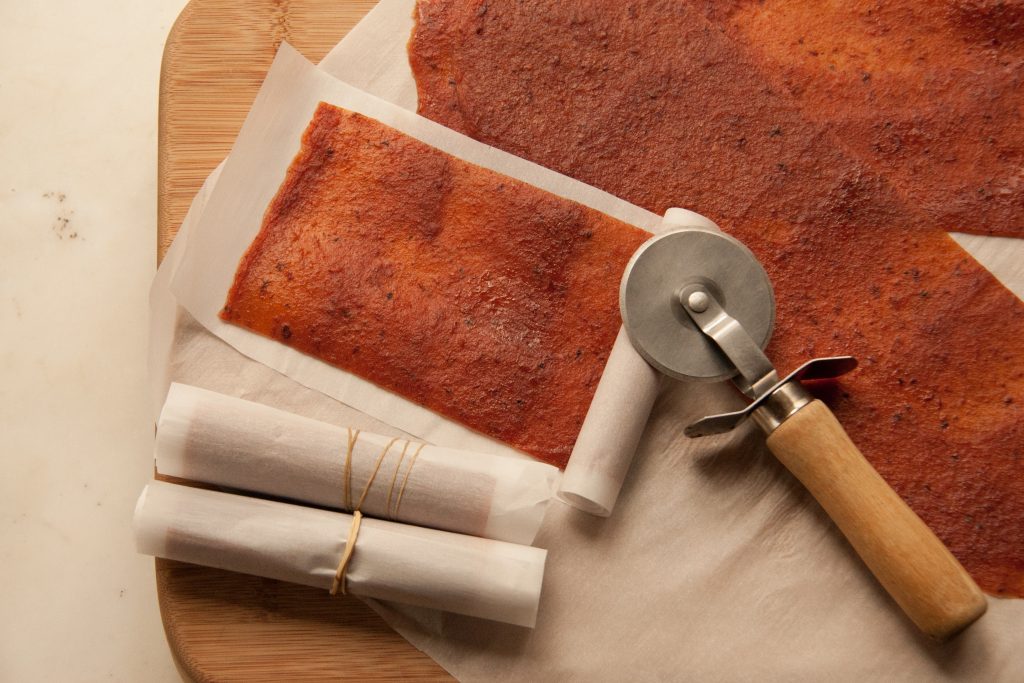
Some of you may remember my obsession with all things crabapple. I’ve just added a new and wonderful recipe to my repertoire: crabapple fruit leather. It’s easy, healthy, and delicious.
Last year I bought myself a steam juicer (Happy Birthday, Ellen!) which makes juicing large quantities of fruit MUCH easier. There’s nothing wrong with the juice you get from simmering fruit in a little water, the way I used to do it. But with a steam juicer, you can process bigger batches of fruit with less work (my ultimate goal in life). Either way, after you’ve juiced your crabapples, you’re left with a pile of pulp. Some people throw the pulp away, some feed it to their chickens, and some people compost it. I don’t have chickens or a compost pile (sue me, my yard is minuscule), and I can’t bear to throw something away if it’s still useful. Which crabapple pulp most definitely is.
If you’re like me, and waste is anathema to you, save that crabapple pulp and make some of the best fruit leather you’ve ever tasted.
What You’ll Need to Make Crabapple Fruit Leather
- crabapple pulp
- your sweetener of choice
- spices (as desired)
What You’ll Do to Make Crabapple Fruit Leather
If your crabapple pulp is cold, the first step is to re-heat it. I usually don’t have time to do my juicing and fruit leather-making on the same day, so I end up refrigerating my pulp. Running cold pulp through a food mill takes A LOT of elbow grease. (Now I understand why my sister used to make her kids do this part.) To make your life easier, transfer the pulp to a large pot, and add a cup or two of water. The amount of water will depend on how much pulp you have, and how dry it is.
Turn the heat on low under the pulp, and stir to keep it from sticking. When the pulp has warmed up and feels loose when you stir it, transfer it to your food mill and start turning. This will remove the stems and most of the seeds.
I like a crockpot for the next step because it lets me walk away from the crabapples while they’re percolating. But you could certainly do this on the stove.
Transfer the puréed crabapples to a crockpot or pot, and turn the heat on low. Taste what you’ve got; it will be very tart. Start adding sugar in small increments until it reaches your desired sweetness level. For ten cups of purée, I used 1 1/2 cups of sugar. Depending on the tartness of your fruit and your sweet tooth, you may want more or less. You have flexibility when it comes to choosing a sweetener. Maple syrup, brown sugar, and honey are all excellent choices, and each will influence the final flavor of your crabapple fruit leather.
Once you’ve reached your perfect sweetness level, it’s time to add your spices. They can be wild (spicebush berries, wild ginger, melilot) or domesticated (cinnamon, nutmeg, allspice, vanilla extract). Add them in small increments; a good place to start is with one teaspoon of spice for every three cups of purée, tasting as you go.
Since this applesauce is destined for fruit leather, you’ll want it slightly stiffer than applesauce you’d eat out of the jar. It needs to be spreadable, but not loose and watery. If your applesauce feels too solid, add a little liquid. This could be apple juice, a little apple cider vinegar, or, maybe that half bottle of ginger beer that’s been sitting in the refrigerator since you made your last Kentucky Belle cocktail.
Scoop a few cups of sauce onto a fruit leather dehydrator sheet and spread it evenly, about 1/8 – 1/4 inch thick. For me, ten cups of purée made four sheets of fruit leather. Set the dehydrator to 135F, and start ‘er up. How long you have to dry the leather will depend on where you live and how much moisture is in your purée. In Santa Fe (high desert) it takes about six hours, and in PA (high humidity) it can take 10 – 12 hours.
Your crabapple fruit leather is done when a poke from your finger doesn’t leave an impression, and it peels easily from the sheet. Use a pizza cutter, a sharp knife, or scissors to cut your leather into slices, then wrap each one in parchment paper or plastic wrap. Store the wrapped fruit leather in a sealed container, out of direct sun.
Your fruit leather will last for a month at room temperature, or a year in the freezer. You can enjoy it as a portable snack, or rehydrate it as crabapple sauce at a later date. The flavor and consistency are perfect, and the color is gorgeous. What more could a forager want?
Leave a Reply